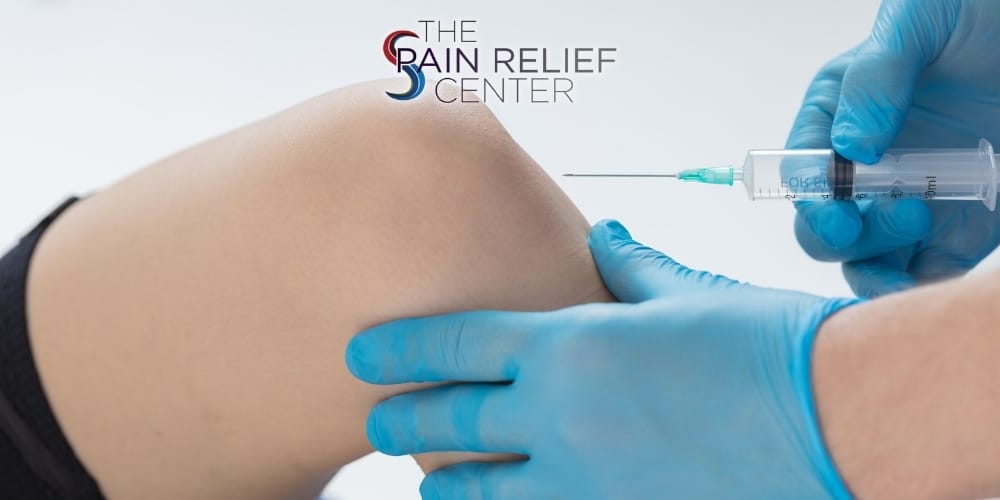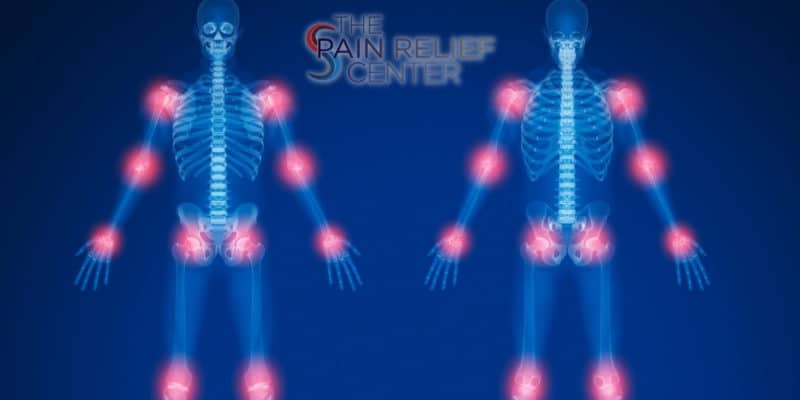JOINT INJECTIONS IN FRISCO AND PLANO TX
DALLAS, FRISCO, AND PLANO JOINT PAIN DOCTOR
PAIN MANAGEMENT TREATMENT OPTIONS

There are nearly countless joint pain causes, one of which is arthritis. In fact, arthritis is one of the leading causes of joint pain. It affects nearly one-fourth of the adult population in the United States. Many treatments and pain management options exist for pain and inflammation of the joints, including joint injections. If you’re looking for effective, long-term pain relief for your joints, injections into the affected joint may be a viable option for you.
At The Pain Relief Center, we offer a wide variety of treatment options for arthritis and other sources of joint pain. Our Dallas pain management doctor can evaluate the source of your pain, develop a customized treatment plan for you, and help you achieve lasting pain relief. To schedule an appointment with us, please call our office at 214-709-1904 or fill out our online intake form today.
What Are Joint Injections?
Many pain management specialists prefer to explore conservative treatment options before recommending surgery. The simple reason is because surgery is much more invasive than conservative treatments, such as joint injections. If a simpler solution can fix the problem, why recommend the last resort option? Joint injections are a quick and easy way to treat joint pain in a variety of locations.
You may benefit from a joint injection in your knee, ankle, elbow, wrist, shoulder, and other small joints. Hip joint injections are also common, but they are slightly more complicated, as they require ultrasound or fluoroscopy guidance. A joint injection would be performed as an outpatient procedure in either a doctor’s office or hospital.
We would begin by thoroughly cleaning the injection site, then administering either local anesthesia or a cold spray to numb the area. Then, we will administer the joint injection into the painful joint. This will provide relief for swelling and pain.
There are several different types of joint injections that serve different purposes. Examples include steroid injections, hyaluronic acid injections (viscosupplementation), PRP injections, placental tissue matrix (PTM) injections, facet joint injections, epidural injections, sacroiliac injections, and other treatments.
Types of Joint Injections
If you’ve decided to try joint injections, it’s important to understand what each type of joint injection is, as well as what it treats. Below, we include a brief overview of each type of joint injection, as well as what they treat.
Platelet-Rich Plasma (PRP) Injections
Platelet-rich plasma (PRP) injections are quickly gaining popularity for treating a wide variety of conditions. This procedure involves using the platelets in a patient’s blood to encourage healing in the body. We extract the blood, separate the platelet-rich plasma from the red blood cells, then inject the PRP directly into the joint. PRP injections can be used to treat the following conditions.
- Healing wounds
- Tendon, ligament, and joint injuries
- Muscle injuries
- Osteoarthritis
- Hair loss
- Skin rejuvenation
Facet Joint Injections
The facet joints are located in the spine, so facet joint injections involve injecting medication into those joints to provide pain relief, reduce inflammation, or even to help someone tolerate physical therapy. A facet joint injection also has a diagnostic purpose, which means that it helps physicians diagnose other conditions. Specifically, it treats the following conditions.
Epidural Injections
Epidural injections help reduce joint swelling and help to manage pain in the spine, arms, or legs. The injection site is located around the epidural space surrounding the spine. Generally, anti-inflammatory medications, anesthetic solutions, or steroid medication is administered in an epidural.
Sacroiliac Injections
The sacroiliac joint is located where your pelvis and lower spine meet. Sacroiliac injections target this specific joint. The procedure usually involves steroid injections and anesthetic. If you suffer from pain that originates in your sacroiliac joint, this is a valid treatment option for you.
Hyaluronic Acid Injections
Hyaluronic acid injections aim to improve movement of the injected joint, as well as reduce inflammation and pain. They can be used in several joints, although the knee is the most common joint treated with hyaluronic acid. These injections can treat a variety of conditions, including knee arthritis, osteoarthritis, and cartilage injuries.
Corticosteroid Injections
Corticosteroid injections, also known as cortisone shots, help to reduce pain and inflammation in the knee and other joints. This treatment is commonly used to provide relief for patients who suffer from the following. Some conditions require repeated cortisone shots, as the effects wear off after some time.
- Gout
- Bursitis
- Back pain
- Rheumatoid arthritis
- Psoriatic arthritis
- Osteoarthritis
- Reactive arthritis
- Tendinitis
Placental Tissue Matrix Injections
Placental tissue matrix (PTM) injections involve the use of tissue from a placenta that is collected from a healthy birth. Placental tissue contains a specific type of stem cells, which help to promote healing and decrease inflammation. These injections can be utilized for a variety of conditions, including the following.
- Degenerative arthritis
- Tendinitis
- Injuries
- Osteoarthritis
Which Injection Is Best for Joint Pain?
This heavily depends on the source of your joint pain. At The Pain Relief Center, we will evaluate your symptoms, diagnose the source of your pain, and develop a personalized treatment plan that works for you. When you suffer from joint pain, we strongly recommend speaking with a doctor for a proper diagnosis. Certain injection types work well for some conditions, but not for others.
Joint Aspiration vs Joint Injections
Many people confuse the terms “joint injection” and “joint aspiration.” Joint injections involve inserting a needle into a joint, then injecting certain medications into it. Joint aspiration, however, involves the use of a syringe to drain fluid out of the joint. Aspiration can be used for certain conditions, such as gout or a joint infection.
What Are the Side Effects of Joint Injections?
As with most medical treatments, joint injections have potential side effects. However, keep in mind that these side effects are very rare, as are complications. Patients should be aware of the following potential risks and side effects.
- A temporary flare of inflammation
- Infection
- Excessive bleeding
- Osteoporosis
- Damage to nearby cartilage, bone, tendons, or nerves
- Lightening of the skin around the injection site
How Long Does a Joint Injection Last?
This largely depends on the type of joint injection you receive. We recommend speaking with your pain management doctor in order to schedule recurrent injections if necessary. Some injuries and conditions may only require one injection, while others may require multiple. Additionally, people’s bodies often react differently to certain medications. Corticosteroid injections, for example, can last anywhere from six weeks to six months, depending on the patient. Some patients even feel relief for as long as a year.
Contact the Pain Relief Center for Joint Injections in Plano and Frisco
If you’re suffering from debilitating joint pain that’s keeping you from living your life, The Pain Relief Center is here for you. We offer a wide variety of treatments for an even wider variety of conditions. Joint pain, specifically, is something that we treat on a very regular basis. Our providers administer several different types of joint injections, all of which help to treat different conditions. If your joint pain has got you down, schedule an appointment with us by calling 214-709-1904 or filling out our online intake form today.
TAKE ACTION
The most critical step on the path to recovery is finding a pain management doctor who can address your pain management needs successfully. The Pain Relief Center and its five specialized institutes are dedicated to meeting any and all of a patient’s needs. Located in the Dallas-Fort Worth area, Dr. Rodriguez and his friendly staff will help you along the path to recovery.
Our new center in Dallas is part of a nationwide development by Pain Relief Centers, geared to providing individualized and comprehensive healing and pain management services with unprecedented levels of compassion, care, and comfort for each patient.



